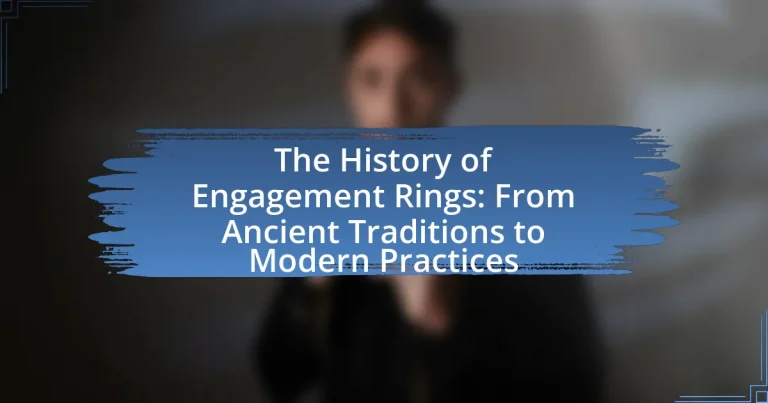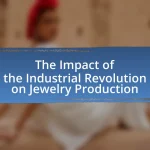The article explores the history of engagement rings, tracing their origins from ancient civilizations to contemporary practices. It highlights the use of braided reeds in Ancient Egypt, iron rings in Rome, and the evolution of materials and designs through various historical periods, including the Middle Ages and the Renaissance. Key milestones, such as the introduction of diamond engagement rings in the 15th century and the impact of marketing campaigns in the 20th century, are discussed. The article also examines modern trends, including ethical sourcing, personalization, and the influence of cultural differences on engagement ring choices today.
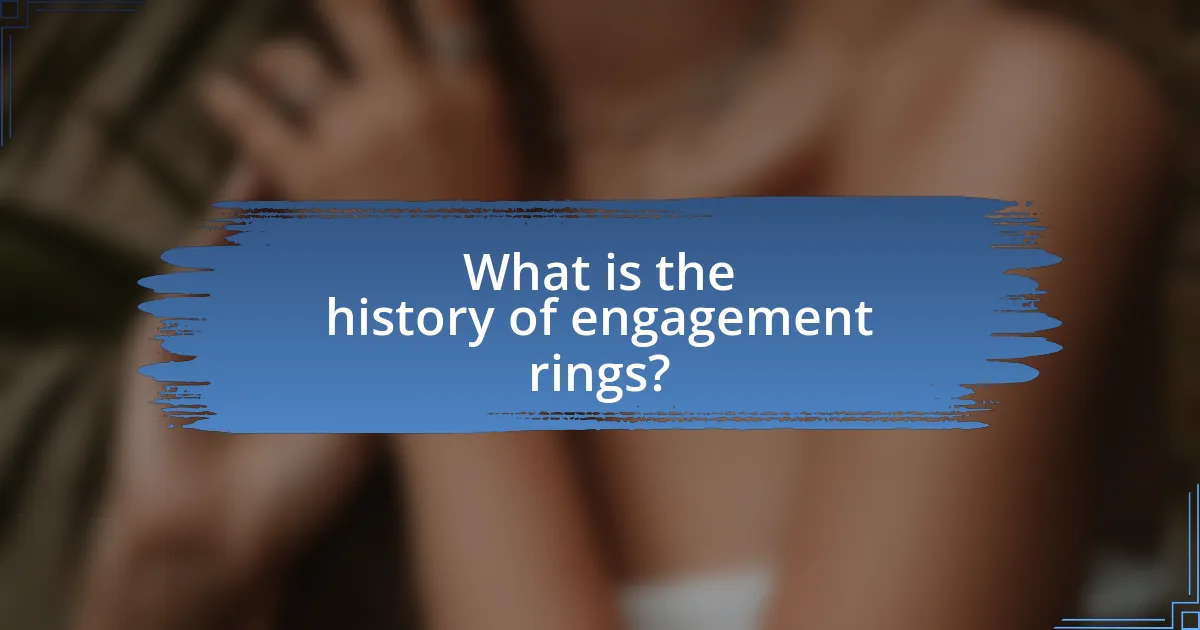
What is the history of engagement rings?
Engagement rings have a history that dates back to ancient civilizations, with the earliest known use occurring in Ancient Egypt around 3000 BC, where rings made of braided reeds symbolized a bond between partners. The Romans later adopted this tradition, using iron rings to signify engagement, which represented strength and permanence. By the Middle Ages, engagement rings became more elaborate, often featuring gemstones, and were commonly used among the European aristocracy. The modern diamond engagement ring trend began in the 15th century when Archduke Maximilian of Austria presented a diamond ring to Mary of Burgundy, setting a precedent for diamond rings as a symbol of love and commitment. This practice gained popularity in the 19th century, particularly after the discovery of diamond mines in South Africa, which made diamonds more accessible. Today, engagement rings are a widespread symbol of love and commitment across various cultures, often featuring a variety of gemstones and styles.
How did engagement rings originate in ancient cultures?
Engagement rings originated in ancient cultures as symbols of commitment and betrothal. In ancient Egypt, rings made of braided reeds or leather were exchanged to signify a binding agreement between partners. Similarly, the Romans popularized the use of iron rings, which represented strength and permanence in a marriage. Historical records indicate that these rings were often worn on the fourth finger of the left hand, believed to have a vein directly connected to the heart, reinforcing the emotional significance of the gesture.
What materials were used in early engagement rings?
Early engagement rings were primarily made from materials such as gold, silver, and various gemstones. Historical records indicate that ancient Romans used iron for engagement rings, symbolizing strength and permanence, while the Egyptians favored gold, which represented eternity. Additionally, gemstones like diamonds, sapphires, and rubies began to be incorporated in later periods, reflecting wealth and status. The use of these materials in early engagement rings highlights their significance in representing commitment and love throughout history.
How did the symbolism of engagement rings evolve in ancient times?
The symbolism of engagement rings in ancient times evolved from simple tokens of betrothal to significant representations of commitment and love. In ancient Egypt, rings made of braided reeds or leather symbolized eternity and were worn on the fourth finger, believed to have a direct connection to the heart. Similarly, in ancient Rome, iron rings were used to signify a binding contract between couples, emphasizing the seriousness of the union. Over time, the introduction of precious metals and gemstones transformed these rings into symbols of wealth and status, further enhancing their significance in representing love and commitment. This evolution reflects changing societal values regarding marriage and relationships throughout history.
What role did engagement rings play in different historical periods?
Engagement rings have served as symbols of commitment and betrothal across various historical periods. In ancient Rome, rings made of iron were used to signify a man’s ownership of his fiancée, reflecting societal norms of the time. During the Middle Ages, engagement rings became more ornate, often featuring gemstones, which represented wealth and status, as well as the promise of fidelity. The 15th century marked a significant shift when Archduke Maximilian of Austria gifted a diamond ring to Mary of Burgundy, popularizing diamond engagement rings among the European aristocracy. In the 20th century, the marketing campaign by De Beers in the 1940s established the diamond engagement ring as a cultural norm, emphasizing the idea that a diamond is a symbol of everlasting love. Each of these historical contexts illustrates how engagement rings evolved from simple tokens of ownership to complex symbols of love and commitment, influenced by societal values and economic factors.
How did the Renaissance influence engagement ring designs?
The Renaissance significantly influenced engagement ring designs by introducing intricate artistry and symbolism. During this period, the revival of classical art and culture led to the incorporation of elaborate motifs, such as floral patterns and geometric shapes, into ring designs. Additionally, the use of precious gemstones became more prevalent, with diamonds gaining popularity as a symbol of love and commitment, particularly after the 1477 engagement of Archduke Maximilian of Austria to Mary of Burgundy, which is often credited with popularizing diamond engagement rings in Europe. This era marked a shift towards personalization and the expression of individual sentiment in jewelry, laying the groundwork for modern engagement ring aesthetics.
What changes occurred in engagement rings during the Victorian era?
Engagement rings during the Victorian era saw significant changes, primarily characterized by the introduction of diamond rings as a popular choice. This shift occurred after the discovery of diamond mines in South Africa in the late 19th century, which made diamonds more accessible and affordable. Additionally, Victorian engagement rings often featured intricate designs, including motifs such as hearts, flowers, and bows, reflecting the era’s romantic ideals. The use of colored gemstones alongside diamonds also became fashionable, showcasing personal taste and individuality. These changes marked a transition from simpler, more utilitarian rings to ornate and symbolic pieces that emphasized love and commitment.
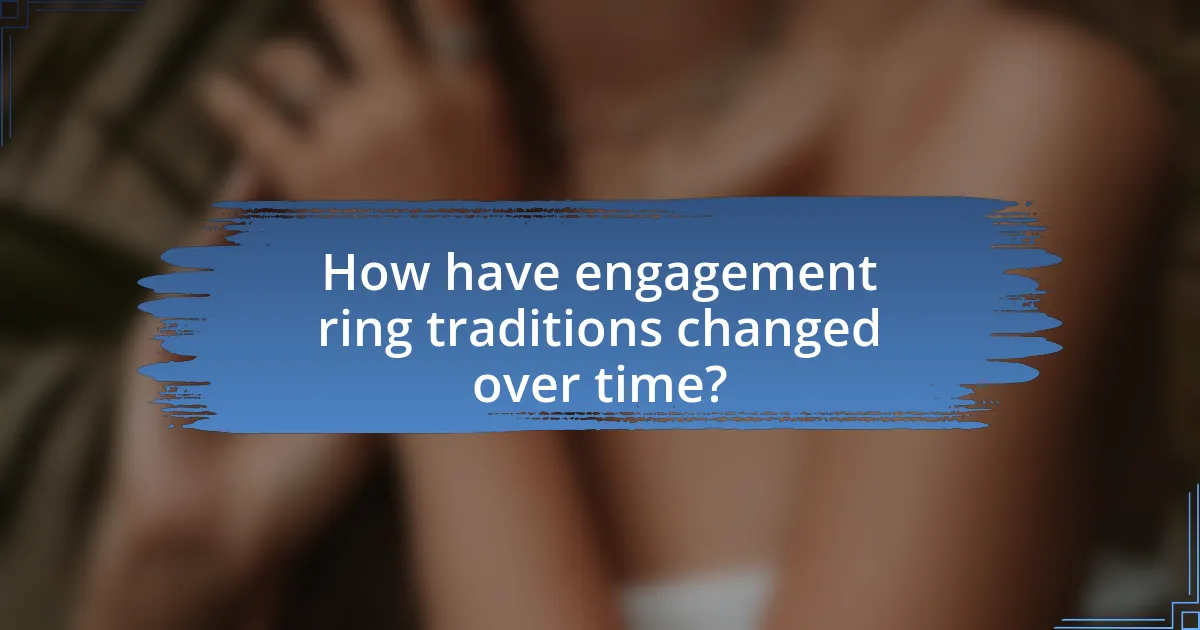
How have engagement ring traditions changed over time?
Engagement ring traditions have evolved significantly from ancient times to the present day. In ancient Rome, rings were made of iron to symbolize strength and permanence, while in the Middle Ages, gold became the preferred material, often featuring intricate designs. The modern tradition of diamond engagement rings began in the 15th century when Archduke Maximilian of Austria presented a diamond ring to Mary of Burgundy, setting a precedent for diamond rings as a symbol of love and commitment. By the 20th century, marketing campaigns, particularly by De Beers in the 1940s, popularized the idea that a diamond should cost two months’ salary, further solidifying the diamond’s status in engagement traditions. Today, engagement rings vary widely in style, material, and cost, reflecting personal preferences and cultural influences, showcasing a shift from uniformity to individual expression in engagement ring choices.
What are the key milestones in the evolution of engagement rings?
The key milestones in the evolution of engagement rings include the Ancient Egyptians’ use of braided reeds and leather to symbolize love, the Romans popularizing gold rings as a sign of betrothal around 2,000 years ago, and the introduction of diamond engagement rings in the 15th century when Archduke Maximilian of Austria gifted one to Mary of Burgundy. The 19th century saw the rise of the modern diamond engagement ring, influenced by the De Beers diamond marketing campaign in the 20th century, which established the “one-month salary” rule for purchasing a ring. Each of these milestones reflects changing cultural values and practices surrounding love and commitment.
How did the introduction of diamonds change engagement ring customs?
The introduction of diamonds significantly transformed engagement ring customs by establishing them as the preferred gemstone for symbolizing love and commitment. Prior to the widespread use of diamonds, engagement rings often featured various other gemstones, but the marketing campaign by De Beers in the mid-20th century popularized the notion that “a diamond is forever,” linking diamonds to enduring love. This campaign led to a cultural shift where diamonds became synonymous with engagement, resulting in a dramatic increase in diamond ring sales, which rose from 10% of the engagement ring market in the 1930s to over 80% by the 1990s. Consequently, diamonds not only became the standard for engagement rings but also elevated the overall significance and value associated with the act of proposing.
What impact did World War II have on engagement ring trends?
World War II significantly influenced engagement ring trends by popularizing simpler, more affordable designs due to economic constraints and material shortages. During the war, many men enlisted, and the need for wartime production led to a scarcity of precious metals and gemstones, prompting couples to opt for less extravagant rings. Additionally, the iconic “We Can Do It!” campaign and the rise of women in the workforce shifted societal norms, leading to a greater emphasis on practicality and emotional significance over opulence in engagement rings. This period also saw the introduction of alternative materials, such as synthetic stones, which became more accepted as a viable option for engagement rings.
Why do modern couples choose specific styles of engagement rings?
Modern couples choose specific styles of engagement rings to reflect their personal tastes, values, and lifestyle preferences. This trend is influenced by a desire for individuality and self-expression, as many couples seek unique designs that resonate with their relationship. Additionally, factors such as cultural significance, ethical sourcing of materials, and the popularity of alternative gemstones contribute to the decision-making process. For instance, a survey by The Knot in 2021 revealed that 70% of couples prioritize personalization in their ring choices, indicating a shift from traditional to more customized options.
What factors influence the choice of metal and stone in contemporary rings?
The choice of metal and stone in contemporary rings is influenced by personal preferences, cultural significance, and market trends. Personal preferences include individual style, color choices, and desired durability, with popular metals like platinum, gold, and rose gold reflecting varying tastes. Cultural significance plays a role, as certain stones, such as diamonds, are traditionally associated with engagement, while other gemstones may hold personal meaning for the couple. Market trends also impact choices, as contemporary designs often incorporate unique materials and ethical considerations, such as lab-grown diamonds, which have gained popularity due to their environmental and ethical implications.
How do cultural differences affect engagement ring selections today?
Cultural differences significantly influence engagement ring selections today by dictating preferences for styles, materials, and symbolism. For instance, in Western cultures, diamond rings are traditionally favored, reflecting a long-standing association with love and commitment, as popularized by De Beers’ marketing campaigns in the 20th century. Conversely, in countries like India, engagement rings may not be as central to the tradition, with gold jewelry often taking precedence due to its cultural significance and value. Additionally, some cultures prioritize colored gemstones or unique designs that reflect personal or familial heritage, showcasing a diverse range of choices influenced by local customs and values. This variation highlights how cultural context shapes individual preferences and practices surrounding engagement rings.
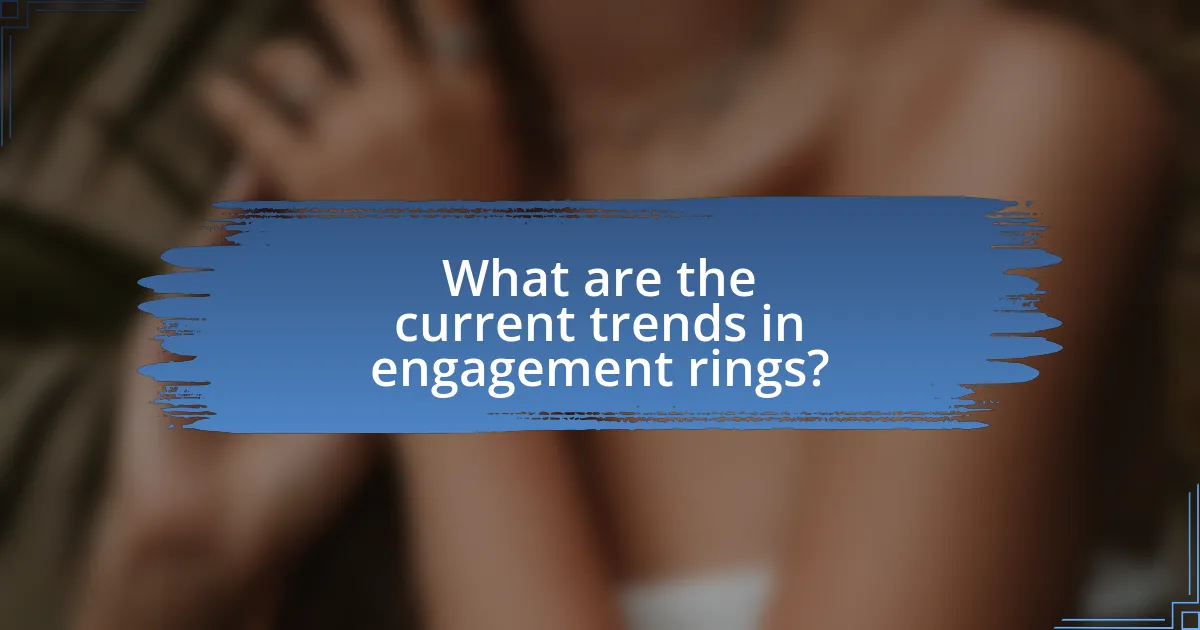
What are the current trends in engagement rings?
Current trends in engagement rings include the rise of lab-grown diamonds, unique gemstone choices, and vintage-inspired designs. Lab-grown diamonds have gained popularity due to their ethical sourcing and cost-effectiveness, with a reported 70% increase in consumer interest over the past few years. Additionally, alternative gemstones like sapphires and emeralds are being favored for their individuality, reflecting a shift towards personalization in jewelry. Vintage and antique styles are also trending, as many couples seek rings that tell a story or have historical significance, aligning with the growing appreciation for sustainability and craftsmanship in the jewelry market.
How do modern designs reflect personal values and preferences?
Modern designs of engagement rings reflect personal values and preferences by prioritizing individuality, sustainability, and symbolism. Consumers increasingly seek unique designs that resonate with their personal stories and beliefs, moving away from traditional styles. For instance, the rise of custom-made rings allows couples to incorporate meaningful elements, such as specific gemstones or engravings that represent their relationship. Additionally, the growing emphasis on ethical sourcing and eco-friendly materials aligns with values of social responsibility and environmental consciousness, influencing choices in modern ring designs. According to a 2021 survey by The Knot, 70% of couples consider ethical sourcing important when selecting an engagement ring, highlighting how personal values directly shape design preferences.
What are the most popular styles of engagement rings today?
The most popular styles of engagement rings today include solitaire, halo, three-stone, and vintage designs. Solitaire rings feature a single diamond or gemstone, emphasizing simplicity and elegance, which has made them a timeless choice. Halo rings, characterized by a center stone surrounded by smaller diamonds, create a sparkling effect and enhance the perceived size of the center stone. Three-stone rings symbolize the past, present, and future of a relationship, making them meaningful and popular among couples. Vintage designs, often inspired by styles from the Victorian, Edwardian, or Art Deco eras, appeal to those who appreciate intricate details and historical significance. According to a survey by The Knot in 2022, solitaire rings remain the most favored style, accounting for 41% of engagement ring purchases, showcasing their enduring popularity.
How has the rise of ethical sourcing impacted engagement ring choices?
The rise of ethical sourcing has significantly influenced engagement ring choices by increasing consumer demand for conflict-free diamonds and sustainable materials. As awareness of unethical mining practices has grown, many consumers now prioritize rings that are certified as ethically sourced, leading to a shift in the jewelry market. According to a 2021 survey by the Diamond Producers Association, 70% of millennials prefer to buy diamonds that are ethically sourced, reflecting a broader trend towards responsible consumerism. This shift has prompted jewelers to offer more options that include lab-grown diamonds and recycled metals, catering to the ethical preferences of modern buyers.
What practical considerations should couples keep in mind when choosing an engagement ring?
Couples should consider budget, style, metal type, and the diamond’s characteristics when choosing an engagement ring. Establishing a budget is crucial, as it helps narrow down options and prevents overspending; the average cost of an engagement ring in the U.S. is around $5,500. Style preferences, whether classic, modern, or vintage, influence the design and setting of the ring. The choice of metal, such as gold, platinum, or silver, affects durability and appearance; platinum is more durable but also more expensive. Additionally, understanding the diamond’s characteristics—cut, color, clarity, and carat weight—ensures that couples select a quality stone that meets their aesthetic and ethical standards, as diamonds are graded based on these factors.
How can couples determine their budget for an engagement ring?
Couples can determine their budget for an engagement ring by assessing their financial situation and setting a realistic spending limit. This involves evaluating income, savings, and monthly expenses to establish how much can be allocated without causing financial strain. According to a 2021 survey by The Knot, the average cost of an engagement ring in the United States was approximately $6,000, but many couples choose to spend less based on their personal circumstances. By discussing their financial goals and preferences together, couples can arrive at a budget that reflects both their values and their financial capabilities.
What tips can help couples select the perfect engagement ring for their relationship?
Couples can select the perfect engagement ring by considering personal style, budget, and the significance of the ring’s features. Understanding each partner’s taste in jewelry is crucial; for instance, some may prefer classic designs while others lean towards modern aesthetics. Establishing a budget helps narrow down options, as engagement rings can range significantly in price, with the average cost in the U.S. being around $5,500 according to The Knot’s 2021 Jewelry and Engagement Study. Additionally, couples should consider the ring’s metal, stone type, and setting, as these elements can reflect their unique relationship. For example, diamonds are traditional, but alternatives like sapphires or lab-created stones are gaining popularity for their ethical considerations and uniqueness.
